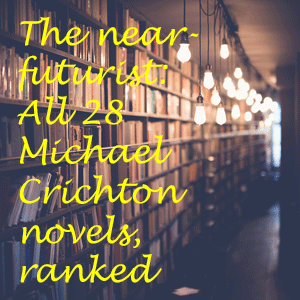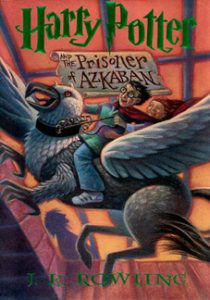For the 20th anniversary of “Harry Potter,” I’m looking back at the books and films of J.K. Rowling’s Wizarding World saga.
“Harry Potter and the Prisoner of Azkaban” (1999) is to young-adult novels what Garbage’s “Only Happy When It Rains” is to rock music. After the fun and world-building of the first two books, the third entry in J.K. Rowling’s saga gets moody and atmospheric. A rock-bottom Harry catches the Knight Bus on a dark London street, the Hogwarts Express is surrounded by dementors as the clouds roll in, and Gryffindor loses to Hufflepuff (yes, to Hufflepuff!) in a Quidditch match in a thunderstorm.
As Rowling writes in Chapter 10, “Grim Defeat”: “The day before the match, the winds reached howling point and the rain fell harder than ever. It was so dark inside the corridors and classrooms that extra torches and lanterns were lit.” I feel a little less guilty about spending my day off reading a “Harry Potter” book if it’s raining outside, and when it’s also raining in the book, that makes it all the better.
The themes of “Azkaban” are as grim as the mood. After testing the waters in “Chamber of Secrets” to find out if kids could handle edgy material (the consensus was that they could, although some critics wrung their hands), Rowling continues to push the envelope. Here she exposes young readers to the cruelties of a government’s sense of “justice” through its use of dementors, wraiths who suck the hope out of prisoners. With a final Kiss, a dementor leaves its victim in an addled state worse than death. It’s no secret that the Eighth Amendment exists in name only in the United States; here, we learn that the Ministry of Magic holds similar disdain for protections against cruel and unusual punishment.
While Sirius Black’s sentence is the result of a mistake (which is still no excuse for Cornelius Fudge and his ilk to disregard his case), the death sentence of Hagrid’s beloved Hippogriff Buckbeak shows how certain people play the system for their own ends. Lucius Malfoy wants to kill the creature who humiliated his son, so he essentially buys off the Committee for the Disposal of Magical Creatures.
“Azkaban” also features happy moments, fleetingly. Indeed, Harry must think of a happy thought in order to produce a Patronus, a magical animal that springs from his wand to fight on his behalf. He finally has success when thinking of – and feeling a connection to — his late father. Whereas “Chamber” takes us back two generations to the time of the young Voldemort, “Azkaban” goes back one generation to the time when Remus Lupin, Peter Pettigrew, Sirius Black and James Potter (a.k.a. Moony, Wormtail, Padfoot and Prongs) had the run of Hogwarts (and its secret tunnels, natch), much to a young Severus Snape’s disgust. The first three are still alive, and they’ll play roles as the series goes forward – Lupin and Sirius on the side of good, Pettigrew as one of Voldemort’s lackeys.

Rowling delivers standout Quidditch writing here (“As a sobbing Wood passed Harry the Cup, as he lifted it into the air, Harry felt he could have produced the world’s best Patronus”). It’s like I’m following the standings of a real sport as I root for Gryffindor to beat Slytherin by more than 150 points in the finale to win their first Quidditch Cup in eight years – and in the last chance for seventh-year captain Oliver Wood. The Pottermore website sorted me into Slytherin, but I am all in for Gryffindor when reading these Quidditch scenes – and for Harry, Ron and Hermione in their non-athletic exploits – and indeed I rather loathe Malfoy, Snape and all the Slytherins. When lost in these books, I have no loyalty to my own House (which, ironically, is arguably a trait of a Slytherin).
“Azkaban” is very classroom-oriented – indeed, thanks to her Time-Turner, Hermione takes more than the maximum number of classes. One of my favorites is Professor Trelawney’s Divination, where Rowling comments on the tricks of mentalists in a more sly fashion than her blunt critique of spotlight-seekers via Lockhart in “Chamber.” Again, the smirk-inducing cleverness is there; my favorite new invention is the Boggart (the British equivalent of the boogeyman), which likes hiding in small and dark spaces. The creature is ideal for Harry to practice his Expecto Patronum spell on. The Marauder’s Map, which shows a young troublemaker the locations of the teachers, is also quite useful.
Yet the plot doesn’t really kick into gear until the entire school year is over. After the students take their final exams, the last 100 pages deliver a rollercoaster ride of tense standoffs and a bevy of revelations. On this re-read, of course, I knew the surprises: Lupin is a werewolf, Black is innocent, Scabbers is Pettigrew, and Pettigrew is the one who actually murdered 12 Muggles and sold out Harry’s parents to Voldemort. But I read it with half a mind on what it would be like for a first-time reader. In 1999, a reader got the full impact of Harry feeling trapped by Sirius, betrayed by Lupin, triumphant after capturing Pettigrew, thrilled that he can live with Sirius instead of the Dursleys, hollow after realizing Buckbeak has been murdered, devastated after failing to produce a Patronus … and yet none of those things actually happen.
Some of this is because of skillful fake-outs from Rowling. “Sorcerer’s Stone” and “Chamber of Secrets” had good mysteries, but the structure was straightforward. “Azkaban,” though, is a head-spinner. If I have one criticism, it’s that Rowling seems to be straining to explain everything clearly in those final chapters; she succeeds, but it’s exhausting. The ultimate twist is Hermione’s Time-Turner, which allows Harry and Hermione to rescue both Buckbeak and Sirius, with only Dumbledore wise to their game. It’s not really a deus ex machina (or at least not a hoary one), because Hermione’s time-travel ability is bluntly teased throughout the book, but it’s still a new ballgame for this series.
As Harry and Hermione strive to keep out of sight of their younger selves from 3 hours ago, Harry flatly states “This is the weirdest thing we’ve ever done,” perhaps reflecting the author’s own sentiments. In the end, Hermione gives the Time-Turner back to McGonagall, and I believe it’s never mentioned again, creating the most oft-cited plot hole of the saga: Whenever something bad happens, why don’t our heroes use the Time-Turner to have a go at setting things right?
However, the sequence is so beautifully structured – particularly when Harry realizes the wizard on the other side of the lake is not his dad, but himself – that I can’t help but forgive it.
Movie review: “Prisoner of Azkaban”
Next book: “Goblet of Fire”

